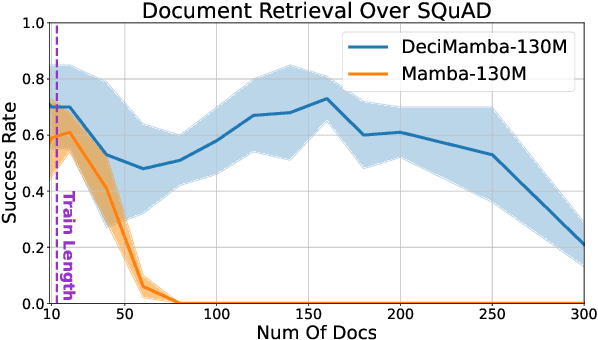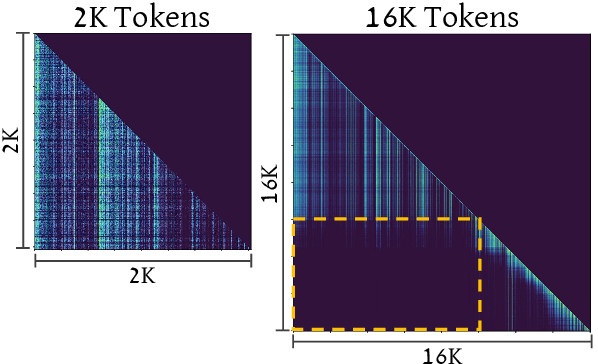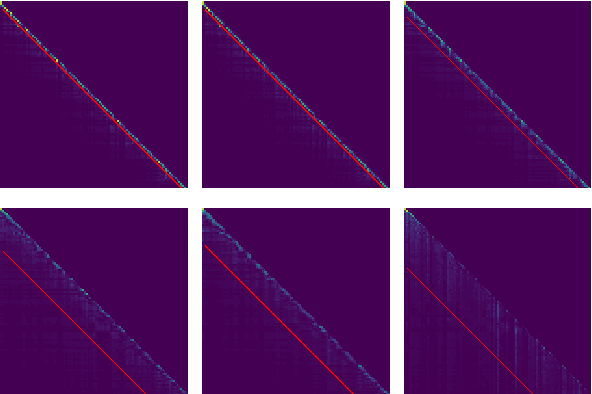Amir Globerson
Hebrew University
Depth-Width tradeoffs in Algorithmic Reasoning of Graph Tasks with Transformers
Mar 03, 2025Abstract:Transformers have revolutionized the field of machine learning. In particular, they can be used to solve complex algorithmic problems, including graph-based tasks. In such algorithmic tasks a key question is what is the minimal size of a transformer that can implement a task. Recent work has begun to explore this problem for graph-based tasks, showing that for sub-linear embedding dimension (i.e., model width) logarithmic depth suffices. However, an open question, which we address here, is what happens if width is allowed to grow linearly. Here we analyze this setting, and provide the surprising result that with linear width, constant depth suffices for solving a host of graph-based problems. This suggests that a moderate increase in width can allow much shallower models, which are advantageous in terms of inference time. For other problems, we show that quadratic width is required. Our results demonstrate the complex and intriguing landscape of transformer implementations of graph-based algorithms. We support our theoretical results with empirical evaluations.
Towards Invariance to Node Identifiers in Graph Neural Networks
Feb 19, 2025Abstract:Message-Passing Graph Neural Networks (GNNs) are known to have limited expressive power, due to their message passing structure. One mechanism for circumventing this limitation is to add unique node identifiers (IDs), which break the symmetries that underlie the expressivity limitation. In this work, we highlight a key limitation of the ID framework, and propose an approach for addressing it. We begin by observing that the final output of the GNN should clearly not depend on the specific IDs used. We then show that in practice this does not hold, and thus the learned network does not possess this desired structural property. Such invariance to node IDs may be enforced in several ways, and we discuss their theoretical properties. We then propose a novel regularization method that effectively enforces ID invariance to the network. Extensive evaluations on both real-world and synthetic tasks demonstrate that our approach significantly improves ID invariance and, in turn, often boosts generalization performance.
On the Expressivity of Selective State-Space Layers: A Multivariate Polynomial Approach
Feb 04, 2025Abstract:Recent advances in efficient sequence modeling have introduced selective state-space layers, a key component of the Mamba architecture, which have demonstrated remarkable success in a wide range of NLP and vision tasks. While Mamba's empirical performance has matched or surpassed SoTA transformers on such diverse benchmarks, the theoretical foundations underlying its powerful representational capabilities remain less explored. In this work, we investigate the expressivity of selective state-space layers using multivariate polynomials, and prove that they surpass linear transformers in expressiveness. Consequently, our findings reveal that Mamba offers superior representational power over linear attention-based models for long sequences, while not sacrificing their generalization. Our theoretical insights are validated by a comprehensive set of empirical experiments on various datasets.
Teaching Models to Improve on Tape
Nov 05, 2024Abstract:Large Language Models (LLMs) often struggle when prompted to generate content under specific constraints. However, in such cases it is often easy to check whether these constraints are satisfied or violated. Recent works have shown that LLMs can benefit from such ``corrective feedback''. Here we claim that this skill of LLMs can be significantly enhanced via training. We introduce an RL framework for teaching models to use such rewards, by simulating interaction sessions, and rewarding the model according to its ability to satisfy the constraints. We refer to our method as CORGI (Controlled Generation with RL for Guided Interaction), and evaluate it on a variety of controlled generation tasks using unlabeled training data. We find that CORGI consistently outperforms the baseline reinforcement learning method that does not incorporate conversational feedback. Furthermore, CORGI's interactive framework enables meta-learning, allowing the LLM to generalize better to guided interaction in new tasks. Our results clearly show that conversational optimization, when combined with reinforcement learning, significantly improves the effectiveness of LLMs in controlled generation contexts.
On the Utilization of Unique Node Identifiers in Graph Neural Networks
Nov 04, 2024Abstract:Graph neural networks have inherent representational limitations due to their message-passing structure. Recent work has suggested that these limitations can be overcome by using unique node identifiers (UIDs). Here we argue that despite the advantages of UIDs, one of their disadvantages is that they lose the desirable property of permutation-equivariance. We thus propose to focus on UID models that are permutation-equivariant, and present theoretical arguments for their advantages. Motivated by this, we propose a method to regularize UID models towards permutation equivariance, via a contrastive loss. We empirically demonstrate that our approach improves generalization and extrapolation abilities while providing faster training convergence. On the recent BREC expressiveness benchmark, our proposed method achieves state-of-the-art performance compared to other random-based approaches.
Provable Benefits of Complex Parameterizations for Structured State Space Models
Oct 17, 2024



Abstract:Structured state space models (SSMs), the core engine behind prominent neural networks such as S4 and Mamba, are linear dynamical systems adhering to a specified structure, most notably diagonal. In contrast to typical neural network modules, whose parameterizations are real, SSMs often use complex parameterizations. Theoretically explaining the benefits of complex parameterizations for SSMs is an open problem. The current paper takes a step towards its resolution, by establishing formal gaps between real and complex diagonal SSMs. Firstly, we prove that while a moderate dimension suffices in order for a complex SSM to express all mappings of a real SSM, a much higher dimension is needed for a real SSM to express mappings of a complex SSM. Secondly, we prove that even if the dimension of a real SSM is high enough to express a given mapping, typically, doing so requires the parameters of the real SSM to hold exponentially large values, which cannot be learned in practice. In contrast, a complex SSM can express any given mapping with moderate parameter values. Experiments corroborate our theory, and suggest a potential extension of the theory that accounts for selectivity, a new architectural feature yielding state of the art performance.
Visual Riddles: a Commonsense and World Knowledge Challenge for Large Vision and Language Models
Jul 28, 2024Abstract:Imagine observing someone scratching their arm; to understand why, additional context would be necessary. However, spotting a mosquito nearby would immediately offer a likely explanation for the person's discomfort, thereby alleviating the need for further information. This example illustrates how subtle visual cues can challenge our cognitive skills and demonstrates the complexity of interpreting visual scenarios. To study these skills, we present Visual Riddles, a benchmark aimed to test vision and language models on visual riddles requiring commonsense and world knowledge. The benchmark comprises 400 visual riddles, each featuring a unique image created by a variety of text-to-image models, question, ground-truth answer, textual hint, and attribution. Human evaluation reveals that existing models lag significantly behind human performance, which is at 82\% accuracy, with Gemini-Pro-1.5 leading with 40\% accuracy. Our benchmark comes with automatic evaluation tasks to make assessment scalable. These findings underscore the potential of Visual Riddles as a valuable resource for enhancing vision and language models' capabilities in interpreting complex visual scenarios.
When Can Transformers Count to n?
Jul 21, 2024Abstract:Large language models based on the transformer architectures can solve highly complex tasks. But are there simple tasks that such models cannot solve? Here we focus on very simple counting tasks, that involve counting how many times a token in the vocabulary have appeared in a string. We show that if the dimension of the transformer state is linear in the context length, this task can be solved. However, the solution we propose does not scale beyond this limit, and we provide theoretical arguments for why it is likely impossible for a size limited transformer to implement this task. Our empirical results demonstrate the same phase-transition in performance, as anticipated by the theoretical argument. Our results demonstrate the importance of understanding how transformers can solve simple tasks.
Do LLMs have Consistent Values?
Jul 19, 2024Abstract:Values are a basic driving force underlying human behavior. Large Language Models (LLM) technology is constantly improving towards human-like dialogue. However, little research has been done to study the values exhibited in text generated by LLMs. Here we study this question by turning to the rich literature on value structure in psychology. We ask whether LLMs exhibit the same value structure that has been demonstrated in humans, including the ranking of values, and correlation between values. We show that the results of this analysis strongly depend on how the LLM is prompted, and that under a particular prompting strategy (referred to as 'Value Anchoring') the agreement with human data is quite compelling. Our results serve both to improve our understanding of values in LLMs, as well as introduce novel methods for assessing consistency in LLM responses.
DeciMamba: Exploring the Length Extrapolation Potential of Mamba
Jun 20, 2024



Abstract:Long-range sequence processing poses a significant challenge for Transformers due to their quadratic complexity in input length. A promising alternative is Mamba, which demonstrates high performance and achieves Transformer-level capabilities while requiring substantially fewer computational resources. In this paper we explore the length-generalization capabilities of Mamba, which we find to be relatively limited. Through a series of visualizations and analyses we identify that the limitations arise from a restricted effective receptive field, dictated by the sequence length used during training. To address this constraint, we introduce DeciMamba, a context-extension method specifically designed for Mamba. This mechanism, built on top of a hidden filtering mechanism embedded within the S6 layer, enables the trained model to extrapolate well even without additional training. Empirical experiments over real-world long-range NLP tasks show that DeciMamba can extrapolate to context lengths that are 25x times longer than the ones seen during training, and does so without utilizing additional computational resources. We will release our code and models.
 Add to Chrome
Add to Chrome Add to Firefox
Add to Firefox Add to Edge
Add to Edge